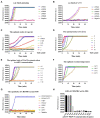Clustered Regularly Interspaced Short Palindromic Repeat/Cas12a Mediated Multiplexable and Portable Detection Platform for GII Genotype Porcine Epidemic Diarrhoea Virus Rapid Diagnosis
- PMID: 35756009
- PMCID: PMC9218691
- DOI: 10.3389/fmicb.2022.920801
Clustered Regularly Interspaced Short Palindromic Repeat/Cas12a Mediated Multiplexable and Portable Detection Platform for GII Genotype Porcine Epidemic Diarrhoea Virus Rapid Diagnosis
Abstract
Porcine epidemic diarrhoea virus (PEDV) is a member of the genus Alphacoronavirus in the family Coronaviridae. It causes acute watery diarrhoea and vomiting in piglets with high a mortality rate. Currently, the GII genotype, PEDV, possesses a high separation rate in wild strains and is usually reported in immunity failure cases, which indicates a need for a portable and sensitive detection method. Here, reverse transcription-recombinase aided amplification (RT-RAA) was combined with the Clustered Regularly Interspaced Short Palindromic Repeat (CRISPR)/Cas12a system to establish a multiplexable, rapid and portable detection platform for PEDV. The CRISPR RNA (crRNA) against Spike (S) gene of GII PEDV specifically were added into the protocol. This system is suitable for different experimental conditions, including ultra-sensitive fluorescence, visual, UV light, or flow strip detection. Moreover, it exhibits high sensitivity and specificity and can detect at least 100 copies of the target gene in each reaction. The CRISPR/Cas12a detection platform requires less time and represents a rapid, reliable and practical tool for the rapid diagnosis of GII genotype PEDV.
Keywords: CRISPR/Cas12a; GII genotype; lateral flow strip; porcine epidemic diarrhoea virus; rapid diagnosis.
Copyright © 2022 Qian, Liao, Zeng, Peng, Wu, Li, Bo, Hu, Nan, Wen, Cao, Xue, Zhang and Dai.
Conflict of interest statement
The authors declare that the research was conducted in the absence of any commercial or financial relationships that could be construed as a potential conflict of interest.
Figures





Similar articles
-
Reverse transcription-enzymatic recombinase amplification coupled with CRISPR-Cas12a for rapid detection and differentiation of PEDV wild-type strains and attenuated vaccine strains.Anal Bioanal Chem. 2021 Dec;413(30):7521-7529. doi: 10.1007/s00216-021-03716-7. Epub 2021 Oct 23. Anal Bioanal Chem. 2021. PMID: 34686895 Free PMC article.
-
Visual detection and differentiation of porcine epidemic diarrhea virus wild-type strains and attenuated vaccine strains using CRISPR/Cas13a-based lateral flow strip.Front Cell Infect Microbiol. 2022 Sep 13;12:976137. doi: 10.3389/fcimb.2022.976137. eCollection 2022. Front Cell Infect Microbiol. 2022. PMID: 36176580 Free PMC article.
-
Rapid detection of Mycoplasma hyopneumoniae by recombinase-aided amplification combined with the CRISPR/Cas12a system.Front Cell Infect Microbiol. 2024 Dec 20;14:1469558. doi: 10.3389/fcimb.2024.1469558. eCollection 2024. Front Cell Infect Microbiol. 2024. PMID: 39760089 Free PMC article.
-
Current State of Molecular and Serological Methods for Detection of Porcine Epidemic Diarrhea Virus.Pathogens. 2022 Sep 21;11(10):1074. doi: 10.3390/pathogens11101074. Pathogens. 2022. PMID: 36297131 Free PMC article. Review.
-
Porcine epidemic diarrhea virus (PEDV): An update on etiology, transmission, pathogenesis, and prevention and control.Virus Res. 2020 Sep;286:198045. doi: 10.1016/j.virusres.2020.198045. Epub 2020 Jun 2. Virus Res. 2020. PMID: 32502552 Free PMC article. Review.
Cited by
-
A new method for the detection of Mycobacterium tuberculosis based on the CRISPR/Cas system.BMC Infect Dis. 2023 Oct 11;23(1):680. doi: 10.1186/s12879-023-08656-4. BMC Infect Dis. 2023. PMID: 37821806 Free PMC article.
-
Rapid detection of feline parvovirus using RAA-CRISPR/Cas12a-based lateral flow strip and fluorescence.Front Microbiol. 2025 Mar 11;16:1501635. doi: 10.3389/fmicb.2025.1501635. eCollection 2025. Front Microbiol. 2025. PMID: 40135058 Free PMC article.
-
Based on the Results of PEDV Phylogenetic Analysis of the Most Recent Isolates in China, the Occurrence of Further Mutations in the Antigenic Site S1° and COE of the S Protein Which Is the Target Protein of the Vaccine.Transbound Emerg Dis. 2023 Feb 22;2023:1227110. doi: 10.1155/2023/1227110. eCollection 2023. Transbound Emerg Dis. 2023. PMID: 40303806 Free PMC article.
-
Development of CRISPR-Mediated Nucleic Acid Detection Technologies and Their Applications in the Livestock Industry.Genes (Basel). 2022 Nov 2;13(11):2007. doi: 10.3390/genes13112007. Genes (Basel). 2022. PMID: 36360244 Free PMC article. Review.
-
New insight in molecular detection of Mycobacterium tuberculosis.AMB Express. 2024 Jun 21;14(1):74. doi: 10.1186/s13568-024-01730-3. AMB Express. 2024. PMID: 38907086 Free PMC article. Review.
References
-
- Chen Q., Li G., Stasko J., Thomas J. T., Stensland W. R., Pillatzki A. E., et al. . (2014). Isolation and characterization of porcine epidemic diarrhea viruses associated with the 2013 disease outbreak among swine in the United States. J. Clin. Microbiol. 52, 234–243. doi: 10.1128/JCM.02820-13, PMID: - DOI - PMC - PubMed
Associated data
LinkOut - more resources
Full Text Sources

